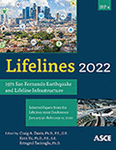Assessing Direct and Indirect Long-Term Economic Impacts from Earthquakes to the US National Bridge Inventory
Publication: Lifelines 2022
ABSTRACT
Using the 2018 National Seismic Hazard Model and the 2018 National Bridge Inventory, an annualized earthquake loss (AEL) study was conducted for approximately 610,000 bridges in the conterminous United States, quantifying both direct and indirect economic losses. The typical AEL framework has been augmented with new replacement unit cost data and bridge-specific parameters for modifying default fragility curves. Earthquake hazard is defined using spectral acceleration hazard curves that account for location-specific soil conditions. Hazard is integrated with bridge-specific fragility curves to compute annual probabilities of exceeding various damage states. Further, economic loss for each bridge was estimated using the repair costs associated with specific damage states and indirect costs incurred from downtimes. Quantitative assessments of seismic risk, especially those that account for downtime-related impacts, enable us to illustrate the distribution of risk with respect to geographic region, era of construction, or type of bridge.
Get full access to this article
View all available purchase options and get full access to this chapter.
REFERENCES
Caltrans (California Department of Transportation) and EDR (Economic Development Research) Group. (2018). Last chance grade economic impact of US-101 closure: A regional impact analysis.
Elnashai, A. S., Hampton, S., Karaman, H., Lee, J. S., Mclaren, T., Myers, J., and Tolbert, N. (2008). “Overview and applications of Maeviz-Hazturk 2007.” J. Earthquake Eng., 12(S2), 100–108.
FEMA. (2012). Multi-hazard loss estimation methodology: Earthquake model (Hazus-MH 2.1 Technical Manual). Washington, D.C.
FHWA (Federal Highway Administration). (2019). “National Bridge Inventory (NBI).” <https://www.fhwa.dot.gov/bridge/nbi.cfm>.
Gidaris, I., Padgett, J. E., Barbosa, A. R., Chen, S., Cox, D., Webb, B., and Cerato, A. (2017). “Multiple-hazard fragility and restoration models of highway bridges for regional risk and resilience assessment in the United States: State-of-the-art review.” J. Struct. Eng., 143(3), 0401618.
Jaiswal, K. S., Bausch, D., Rozelle, J., Holub, J., and McGowan, S. (2017). Hazus estimated annualized earthquake losses for the United States (FEMA P-366).
Jaiswal, K. S., Bausch, D., Chen, R., Bouabid, J., and Seligson, H. (2015). “Estimating annualized earthquake losses for the Conterminous United States.” Earthquake Spectra, 31(1_suppl), S221–43.
Jaiswal, K. S., Kwong, N. S., Yen, S., Bausch, D., Lin, K. W., Luco, N., Wald, D. J., and Rozelle, J. (2020). “Assessing the long-term earthquake risk for the US National Bridge Inventory.” Proc., 17th World Conference on Earthquake Engineering, Sendai, Japan.
Kilanitis, I., and Sextos, A. (2018). “Impact of earthquake-induced bridge damage and time evolving traffic demand on the road network resilience.” Journal of Traffic and Transportation Engineering, 6(1), 35–48.
McGuire, R. K. (2004). Seismic Hazard and Risk Analysis. Earthquake Engineering Research Institute.
Petersen, M. D., Moschetti, M. P., Powers, P. M., Mueller, C. S., Haller, K. M., Frankel, A. D., and Olsen, A. H. (2015). “The 2014 United States National Seismic Hazard Model.” Earthquake Spectra, 31(S1), S1–30.
Petersen, M. D., Shumway, A. M., Powers, P. M., Mueller, C. S., Moschetti, M. P., Frankel, A. D., and Zeng, Y. (2019). “The 2018 update of the US National Seismic Hazard Model: Overview of model and implications.” Earthquake Spectra, 36(1), 5–41.
RITS (Rutgers Intelligent Transportation Systems) Laboratory. (2010). Cost/benefit analysis of NJDOT Route 23 Sussex borough realignment and Papakating Creek bridge replacement project.
Wald, D. J., and Allen, T. I. (2007). “Topographic slope as a proxy for seismic site conditions and amplification.” Bulletin of the Seismological Society of America, 97(5), 1379–95.
Werner, S. D., Taylor, C. E., Cho, S., Lavoie, J., Huyck, C. K., Eitzel, C., and Eguchi, R. T. (2006). REDARS 2 Methodology and software for seismic risk analysis of highway systems.
Werner, S. D., Taylor, C. E., and Moore, J. E. (1997). “Loss estimation due to seismic risks to highway systems.” Earthquake Spectra, 13(4), 585–604.
Zamichow, N., and Ellis, V. (1994). “Santa Monica freeway to reopen on Tuesday: Recovery: The contractor will get a $14.5-million bonus for finishing earthquake repairs 74 days early.” Los Angeles Times, <https://www.latimes.com/archives/la-xpm-1994-04-06-mn-42778-story.html>.
Information & Authors
Information
Published In
History
Published online: Nov 16, 2022
Authors
Metrics & Citations
Metrics
Citations
Download citation
If you have the appropriate software installed, you can download article citation data to the citation manager of your choice. Simply select your manager software from the list below and click Download.
